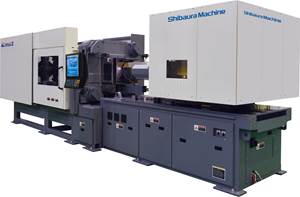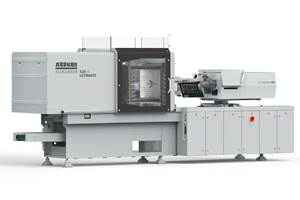Tips For Injection Molders: IMD Tooling & Robotics
Injection molders looking to get in on the IMD action should ask plenty of questions: What are the mold-design considerations?
Injection molders looking to get in on the IMD action should ask plenty of questions: What are the mold-design considerations? What type of robot might handle the film insert well? What are the requirements for the end-of-arm tooling? How is the insert held in the tool? What are the issues related to back-molding?
To help answer these questions, we sought advice from a small sample of molders and suppliers of molds, robots, injection machines, and materials. Not all of those we contacted were willing to contribute to this article, partly due to concerns over customer secrecy. So keep in mind that the firms quoted here represent only a fraction of those that have knowledge and experience of the IMD process.
A toolmaker’s perspective
Build-A-Mold in Canada has manufactured a number of tools for automotive IMD applications, says Horst Schmidt, director of R&D. The company has created IMD tools for exterior parts up to 72 in. long, including front and rear fascias, taillight panels, rocker panels, body side moldings, and bumper caps. Yet it has not been easy. The moldmaker requires large blocks for these IMD parts and they must have an extremely smooth surface finish.
“A cavity and core are usually cut in stainless steel, but sizes for these IMD exterior parts exceed the typical maximum block size (36 x 36 x 36 in.) for stainless,” says Schmidt. Conventional forging can reduce the grain size through a block of stainless steel up to 30 in. thick. “Larger blocks of stainless steel aren’t typically produced because the grain structure inside the metal affects surface porosity. A porous surface makes polishing very difficult,” says Schmidt. To obtain a Class A or nearly lens-quality surface, Build-A-Mold has resorted to hardened P20 tool steel for its big IMD jobs.
IMD film supplier GE Plastics warns that you must account for the film thickness when molding thin-wall parts. Says Luca Saggese, process development engineer, “Make sure the tool is designed for IMD. If it isn’t, you might lose up to 30% of the part thickness to the film.”
Injection press supplier Battenfeld of America has sold several machines for back molding of dry-paint film inserts. Juergen Ehritt, manager of process engineering, warns of several tooling issues to be addressed: “If you use multiple gates you can get a weld line that appears on the flat surface of the film. And there are issues of venting, too.” He recommends venting at the edges of the part. Ehritt notes that IMD requires very careful control of filling sequence and flow patterns. “A low injection-pressure profile is desired. You must watch gate location or reduce the flow lengths.” Using multiple valve gates may be one solution for some applications.
Get the automation right
For Mayco Plastics, a Detroit-area automotive molder and supplier of IMD films, arranging the automation was the top priority in its manufacturing cell used to make IMD parts. Says Mayco president Tim Hoefer, “Depending on the complexity of the application, we’ll use four or five six-axis robots.” He considers six-axis servo robots, with their wide range of motion, valuable to give the cell maximum flexibility.
Mayco’s IMD cell includes a thermoformer to preform the sheet inserts (which Mayco extrudes itself), and a 3000-ton Milacron press to back-mold the parts. To produce front and rear fascias for the Dodge Neon, Mayco uses an overhead gantry beam fitted with two six-axis robots from Fanuc Robotics. The first robot places the insert on the cavity side while the second removes the finished part and places it on a trimming fixture. A floor-mounted six-axis robot carries out the trimming.
Mayco minimizes human intervention in the process. One person is sufficient to place a stack of film inserts where they can be picked up by the robot and to remove the finished parts after trimming. By contrast, Hoefer says, “A paint line might have 30 people.”
Mayco has developed proprietary expertise in robot end-of-arm tooling (EOAT). “There is certainly some complexity there,” says Hoefer, “which provides consistent engagement of the film, film transfer, and film positioning. We have interfaces between the robot and mold to ensure process repeatability. The EOAT won’t put a film in the mold that is not properly aligned for the mold. There is some allowance on the placement accuracy of the insert, but it is not generous.”
Mayco performs IMD operations in an environmentally controlled facility of the clean-room type, to ward off dust contamination of the film insert. “It’s not a medical- or electronics-level clean room, but a thermoformer or injection molder of automotive parts wouldn’t normally see this,” comments Hoefer.
Joseph Portelli, plastics industry program manager at Fanuc Robotics America, explains why six-axis, jointed-arm, servo robots are right for IMD applications: “Six degrees of freedom provide the full articulation necessary to completely tweak the film placement. This is critical because if the location or orientation are off, pinches or wrinkles may appear in the film, which in turn may let the substrate material creep in front of the film.”
Of course, conventional traversing robots are also being used for IMD. Knowledgeable sources point out that an all-servo robot may be a better choice in such cases than a pneumatic or hybrid pneumatic-and-servo robot, as servo positioning is more accurate, repeatability is greater, and motions can be adjusted more easily.
Handle with care
IMD films require delicate handling. Fanuc’s Portelli notes that some molders have used acetal or fluoropolymer fingers in the robot’s EOAT to handle the film without marring the surface. Suction cups are another popular approach. Portelli advises turning on the suction slowly to pick up the film insert without harming it. A regulator can be used to monitor the vacuum draw.
Positioning and holding the film in the mold are also critical considerations in IMD. Build-A-Mold has found that adding a static charge to the preformed film insert helps the preform stay positioned accurately in the tool. “Using static charge on the film allows you to position the film in the mold without the use of mechanical components such as a dowel or a vacuum vent, which may mar the film,” says Schmidt.
GE’s Saggese agrees that turning on a static charge (10,000 to 20,000 V for 2 sec) can assist in accurate positioning of the film into the mold. He also says one way to hold the film firmly in the tool is with spring-loaded pins that engage the film when the tool closes. One more technique is to use “core action to completely cover the tool with the film in a way that doesn’t leave a witness on the part,” he adds.
More tips on technique
Sources interviewed for this article frequently mentioned proper dimensioning of the film inserts as an important factor that’s easily overlooked. “Make sure the film is slightly undersized in relation to the final part size,” advises Schmidt of Build-A-Mold. “When the film is back- molded, it will stretch due to thermal expansion by the incoming substrate.” The film would flash in the mold if it were cut to finished-part size before back-molding. Battenfeld’s Ehritt adds, “You must calculate how the film will expand first when it heats up to the tool temperature, and then when the substrate is injected.”
In the same vein, don’t overlook the possibility of differential shrinkage between the skin and the back-molded substrate, these sources warn. If the skin material and substrate are properly chosen for compatibility, shrinkage rates will be similar and post-molding adhesion will not be compromised.
Ehritt adds one more caution: “Back-molding requires some expertise. If you inject the substrate material too fast you can create a wrinkling or rippling effect on the film.”
Related Content
Completely Connected Molding
NPE2024: Medical, inmold labeling, core-back molding and Industry 4.0 technologies on display at Shibaura’s booth.
Read MoreBreaking News From NPE2024
Here is a firsthand report of news in injection molding, extrusion, blow molding and recycling not previously covered.
Read MoreKurz Opens New Plant in Vietnam
The maker of decorative thin films invested 37 million euros in the new 60,000-m2 plant in Quy Nhơn, which joins regional production facilities in China and Malaysia.
Read MoreIn-Mold Labeling Applied to Medical
In collaboration with multiple partners, Arburg will showcase IML for centrifuge tubes at Fakuma 2023, eliminating printing or other downstream steps.
Read MoreRead Next
Beyond Prototypes: 8 Ways the Plastics Industry Is Using 3D Printing
Plastics processors are finding applications for 3D printing around the plant and across the supply chain. Here are 8 examples to look for at NPE2024.
Read MorePeople 4.0 – How to Get Buy-In from Your Staff for Industry 4.0 Systems
Implementing a production monitoring system as the foundation of a ‘smart factory’ is about integrating people with new technology as much as it is about integrating machines and computers. Here are tips from a company that has gone through the process.
Read MoreFor PLASTICS' CEO Seaholm, NPE to Shine Light on Sustainability Successes
With advocacy, communication and sustainability as three main pillars, Seaholm leads a trade association to NPE that ‘is more active today than we have ever been.’
Read More





















